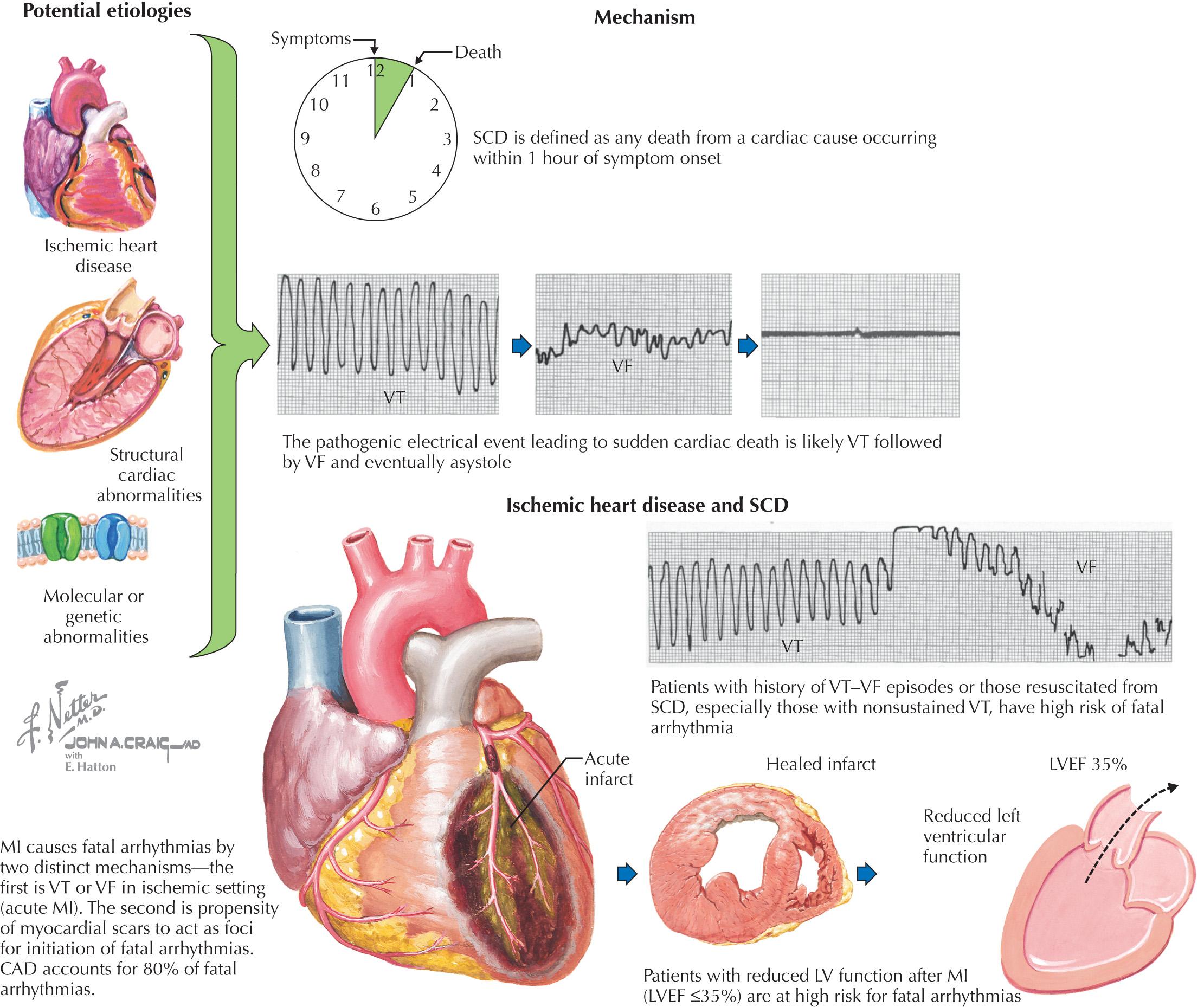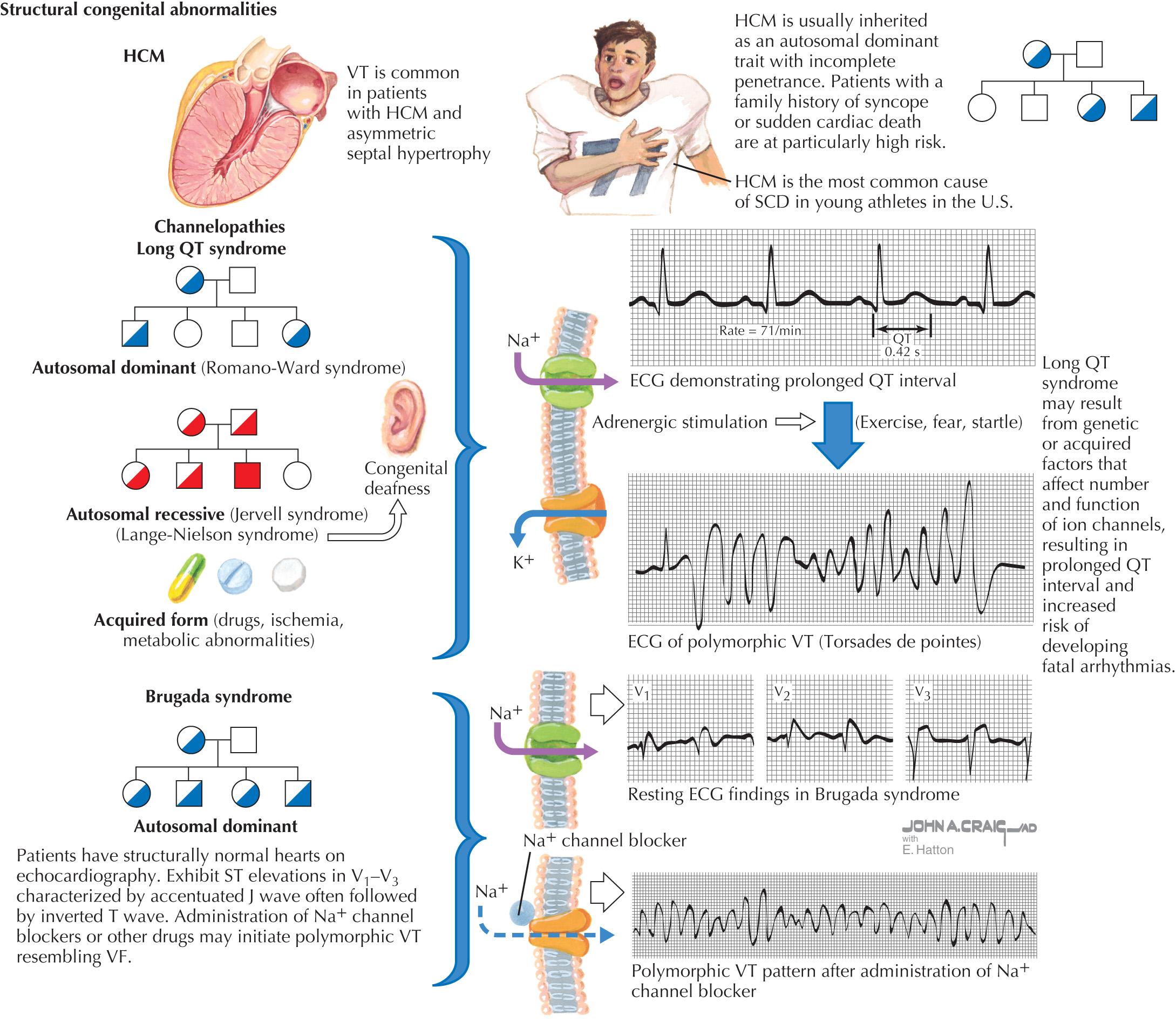Physical Address
304 North Cardinal St.
Dorchester Center, MA 02124
Sudden cardiac death (SCD) is defined as any death from a cardiac cause occurring within an hour of symptom onset. The term sudden cardiac arrest (SCA) refers to an event from which an individual is resuscitated or spontaneously recovers. Sudden unexpected death has many potential etiologies ( Box 42.1 ). Patients with coronary artery disease (CAD) and previous myocardial infarction (MI) have an annual incidence of SCD of up to 30%, which is responsible for approximately 70% of fatal arrhythmias. Other high-risk groups include patients with previous cardiac arrest, congestive heart failure, cardiomyopathy (dilated, infiltrative, or hypertrophic), valvular heart disease, myocarditis, and congenital heart disease (CHD). Screening patients potentially at risk for SCD and addressing their risk factors is the crux of primary prevention. Secondary measures aim to prevent recurrent events in survivors of aborted SCA ( Fig. 42.1 ).
Coronary atherosclerosis (myocardial ischemia or infarction)
Congenital coronary anomalies
Arteritis
Dissection
Coronary spasm
Dilated cardiomyopathy
Hypertrophic cardiomyopathy
Arrhythmogenic RV dysplasia or cardiomyopathy
Congenital heart disease (tetralogy of Fallot, Ebstein anomaly, transposition of great arteries)
Long QT syndrome
Brugada syndrome
Idiopathic VF
Catecholaminergic polymorphic VT
Commotio cordis
Metabolic derangements
Pulmonary embolism
Drug induced
Aortic rupture or other intravascular catastrophe
Intracranial hemorrhage
Airway obstruction
RV , Right ventricular; VF , ventricular fibrillation; VT , ventricular tachycardia.
SCD occurs in 300,000 to 450,000 individuals in the United States annually. According to death certificates, SCD accounts for 15% of the total mortality in the United States. However, death certificates may overestimate the true prevalence of SCD as suggested by some investigators. In 1 study, the incidence of SCD according to death certificates in a particular year was 153 per 100,000, but when true causes of death were investigated by looking at findings in the medical records and autopsy results, the incidence of SCD (i.e., sudden unexpected death due to cardiac causes) was only 53 per 100,000 in the same population in that particular year. The causes of unexpected death due to noncardiac causes are many. Men are two to three times more likely to experience SCD than women (a few examples are shown in Box 42.1 ).
The pathogenic electrical events leading to SCD are most commonly ventricular tachycardia (VT), ventricular fibrillation (VF), and eventually asystole ( Fig. 42.2 ). Approximately 80% of SCDs involve VT, VF, or Torsades de pointes; the remaining 20% are due to bradyarrhythmias. SCD is most commonly associated with underlying structural heart disease. Less than 20% of out-of-hospital victims of SCA recover to hospital discharge. The likelihood of resuscitation diminishes 10% for every minute of delay. It has been estimated that 50% of those who survive a cardiac arrest will die within 3 years. This underscores the importance of primary and secondary prevention.

CAD accounts for 70% to 80% of SCD cases, especially in Western societies in patients aged older than 35 years. As such, two of the leading risk factors are previous heart attack and documented CAD. In those with chronic ischemic disease, the most powerful predictor is an ejection fraction (EF) <40%. Following CAD, patients with nonischemic cardiomyopathies (hypertrophic and dilated) and an EF <40% are at the highest risk. Additional major risk factors for SCD include congestive heart failure of any etiology and a history of cardiac arrest. Channelopathies (e.g., long QT syndrome and Brugada syndrome) result in an increased risk for cardiac arrhythmias and SCD. CHDs are less common causes of SCD.
The most common etiologies are discussed in the sections that follow (see also Box 42.1 ).
Overwhelmingly, the most common cause of SCD is ischemic heart disease that results from coronary atherosclerosis. Arteritis, dissection, spasm, and congenital coronary anomalies are rare causes associated with myocardial ischemia. CAD has been attributed to 70% to 80% of all SCDs. In a study of 84 survivors of out-of-hospital cardiac arrest, immediate coronary angiography revealed significant disease of probable etiologic significance in 71% of patients; approximately one-half of these patients had complete occlusions. Acute occlusion of the left anterior descending or left circumflex coronary artery portends a higher risk of SCD. Patients with angina and previous MI are at much higher risk than those without any clinical manifestation of CAD. Unfortunately, SCD can be the first manifestation of CAD in one-third of CAD patients.
Causes of SCD in the CAD population include myocardial ischemia or MI, heart failure, electrolyte imbalance, drug toxicity, or primary (no precipitating cause identified). The probable mechanisms for VT or VF in patients with CAD are acute ischemia and reentry via myocardial scar, especially in those with a previous infarction. A meta-analysis of four non–ST-elevation MI trials found the risk of sustained or unstable ventricular arrhythmias (VT or VF) to be 2.1% (vs. 10% in ST-segment elevation MI [STEMI]) during the initial hospital admission. Patients with VT and VF had the highest mortality rate in the first 30 days (>60%) post-MI, followed by patients with VF only (>45%), followed by patients with VT only (>30%). This trend was consistent at 6 months, which correlated with a 5- to 15-fold increase in mortality within 6 months in patients with these arrhythmias. Patients in the Global Utilization of Streptokinase and Tissue Plasminogen Activator for Occluded Coronary Arteries (GUSTO I) Trial, which studied fibrinolytic therapies for STEMI, demonstrated higher overall incidences of sustained arrhythmias than in non-STEMI patients: specifically, 3.5% for VT only, 4.0% for VF only, and 2.6% for both VT and VF. Of these arrhythmias, 80% to 85% occurred within the first 48 hours (“early”). In-hospital mortality and 1-year mortality (for those who survived >30 days) after discharge of these patients were much higher among those with VT, VF, or VT and VF (18.6%, 24%, or 44% in-hospital, and 7.2%, 2.9%, or 7.1% at 1 year, respectively) than patients without these arrhythmias (4.2% in-hospital and 2.7% at 1-year). Patients with “late” (after the first 48 hours) ventricular arrhythmias had increased mortality at 1 year (24.7% for VT, 6.1% for VF, 4.7% for VT and VF) and were more likely to have had a previous MI, previous bypass surgery, and a longer time from the onset of MI and receiving treatment.
Ten percent to 15% of SCD cases are attributable to cardiomyopathies not associated with CAD. In patients with dilated cardiomyopathies, the presence of nonsustained VT, syncope, and/or advanced heart failure are high-risk predictors. SCD is the major cause (up to 72% in some studies) of death in patients with nonischemic cardiomyopathy. Most fatal arrhythmias are believed to be tachyarrhythmias, mainly polymorphic, and the less commonly monomorphic VTs. The primary mechanisms of polymorphic VT and VF are unknown, but subendocardial scarring, and interstitial and perivascular fibrosis are probably involved. A particular type of monomorphic VT (see Chapter 41 ) caused by bundle branch reentry is characteristic of nonischemic cardiomyopathy. In bundle branch reentry, a macro-reentrant circuit that involves both bundles, the Purkinje system, and the myocardium can be documented.
Hypertrophic cardiomyopathy (HCM) is an autosomal-dominant inherited disorder estimated to affect 1 in 500 adults (see Chapter 30 and Fig. 42.3 ). The overall risk of SCD in patients with HCM is estimated at 1% to 4% per year, but within subgroups of patients with this disease the risk of SCD varies substantially. All first-degree relatives of a patient with HCM who had SCD must be screened. Generally, patients with HCM who are at highest risk for SCD are those with recurrent syncope, nonsustained VT on Holter monitoring, extreme left ventricular hypertrophy on an echocardiogram (>30 mm), abnormal blood pressure response to exercise, and a positive family history of SCD from HCM. Careful evaluation for HCM is of utmost importance in young individuals because HCM is the most common cause of SCD in young athletes in the United States ( Fig. 42.3 ). Genetic testing of first-degree relatives of an individual whose gene mutation has been identified may help establish risk but remains a controversial screening modality. Screening should include a detailed history and physical examination, ECG, and echocardiography.

Become a Clinical Tree membership for Full access and enjoy Unlimited articles
If you are a member. Log in here